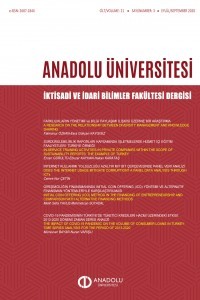
Anadolu Üniversitesi İktisadi ve İdari Bilimler Fakültesi Dergisi
Yazarlar: Özgür TONUS, Sanem BAYKAL
Konular:İktisat
Anahtar Kelimeler:Anayasa hukuku
Özet: Avrupa'nın Geleceği Konvansiyonu çalışmalarını tamamlayarak Anaya- sal Antlaşma Taslağı'nı 18 Temmuz 2003 tarihinde AB Dönem Başkanlığı'na sunmuştur. AB'nin kurumsal yapısında bazı temel değişiklikler öngören bu Taslak, Hükümetlerarası Konferansta tartışılarak -değişikliklerle birlikte- AB , üyesi ülkelerin oybirliği ile karara bağlanacaktır. Konvansiyon'un amacı iki yönlüdür: Bir taraftan Birliğin kurumsal ve hukukı yapısını genişlemeye hazırlamak, diğer taraftan ise bütünleşme sürecini derinleştirmek. Bu bağlamda Konvansiyon, bugüne kadar hep var olan Avrupa bütünleşmesi konusundaki kutuplaşmaların arenası haline gelmiş, Avrupa yanlıları ile federasyon yanlıları arasındaki bu tartışmalar hem tarafları memnun ederken, hem de dengeyi koruyan sonuçları yansıtmıştır. Hazırlanan Anayasal Antlaşma Taslağı'nda da dengeler büyük ölçüde korunmuştur. The Convention on the Future of Europe has completed its work and submitted the "Draft Treaty Establishing a Constitution for Europe" to the Presidency on the 18th of July, 2003. This "draft" which brings forth certain fundamental changes to the institutional structure of the Union will now be discussed and adopted-albeit with amendments- by the Intergovernmental Conference, by the consensus of the EU Member States. The Convention's objective was twofold; to prepare the Union's institutional and legal structure on the one hand for the widening, and on the other, for the deepening of the integration process. In that context, the Convention has been the arena of the ever-present dichotomy of the European integration; the debate between the intergovernmentalists and federalists and the outcome reflects the attempts of striking and preserving a balance. Here it is submitted that such balance has been preserved to a huge extent.